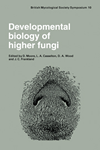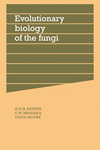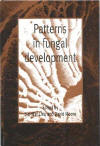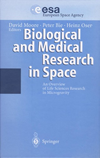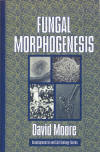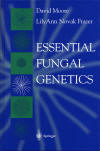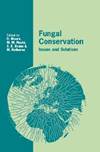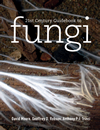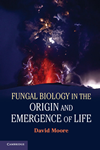9. Reaction with an extracellular matrix
In several examples detailed by Umar & Van Griensven (1998) the programme leading to cell death involves the sacrificed cells over-producing extracellular matrix and then lysing to release it. Evidently, the process is not simply one of killing cells at particular times and in particular places. The cell contents which are released when the cells die seem to be specialised to particular functions too. In the autolysing Coprinopsis gills the cell contents released on death contain heightened activities of lytic enzymes. The cell deaths which carve out the shapes of fruit body primordia release mucilaginous materials. It seems, therefore, that this cell death programme includes a subroutine which causes the cells to synthesise large quantities of extracellular matrix for release when the cell lyses.
The fungal extracellular matrix is extensive and complex (Fig. 36). It provides the environment within which reinforcement of differentiation can occur. Hyphal cells require reinforcement of their differentiation 'instructions'. This reinforcement is part of the context within which they normally develop and may involve production of location- and/or time-specific extracellular matrix molecules and/or smaller molecules serving as hormones or growth factors.
 |
| Fig. 36. Fruit body initials of Pleurotus pulmonarius. An entire initial is shown at left, similar to that shown in the left-hand image of Fig. 35, but here the specimen has been imaged using an Ectroscan environmental SEM which operates at a sufficient water vapour pressure to enable imaging of live tissue which is still wet. This photograph shows that living hyphae are surrounded by a sheath of mucilage, shown in higher magnification in the middle micrograph. Frozen and partially-desiccated mucilage can be imaged in conventional cryo-SEM preparations (right-hand micrograph). Photographs kindly provided by Dr Carmen Sánchez. |
It is important to note that uptake of a signal into the intracellular environment is not an essential process because the signalling molecules may react with integrins in the plasmalemma and the existing extracellular matrix. Such direct effects on the cytoskeleton can cause immediate metabolic changes in one or more cellular compartments and may directly influence gene transcription. This phenomenon is well established in many animal systems and is known as 'outside-in' signalling and often involves integrins.
This is perhaps the place to describe my involvement in research on the influence of polyacrylic acids and their salts on the surface properties of fungal spores and mycelia. The primary aim of this research was to modify the growth form of mycelia in fermenter cultures, but for me the main outcome was that the research showed how the local environment could influence hyphal morphogenesis and the importance of autotropism in determining morphology. First, the electrophoretic behaviour of freshly harvested spores of Aspergillus niger, Phanerochaete chrysosporium and Geotrichum candidum, which is expected to depend on the balance of ionic charges on the surface of the spore wall, was determined in solution at various pH values by measuring the time taken for spores to traverse 32 μm in a cytopherometer observed on the stage of a phase contrast microscope. Freshly harvested spores of all three species lacked positive mobility at pH 2, suggesting a preponderance of acidic surface groups. Spores of the ‘non-aggregating’ fungus, G. candidum, had a pH-mobility curve (peak of negative mobility between pH 3 and 4) which was quite different to those of spores of the ‘aggregating’ fungi, A . niger and P. chrysosporium.
The pH-mobility curve of swollen spores of A . niger which had been incubated in medium differed from that of freshly harvested spores, suggesting that changes in the wall that occur during germination alter the electrophoretic properties of the spores; swollen spores of A . niger, unlike freshly harvested spores, had a negative mobility maximum at pH 5.0. After treatment with Junlon PW110 (a polyacrylic acid), spores of all three species had similar pH-mobility curves and all had peaks of negative mobility at pH 4.0. The electrophoretic mobility of spores of P. chrysosporium at pH 6.5 increased linearly with the concentration (0.01- 0.4%, w/v) of Junlon used in the pre-treatment; electrophoretic mobility after pre-treatment with 0.005-0.1 % (w/v) Hostacerin (sodium polyacrylate) increased only up to 0.01 % (w/v) Hostacerin. The results obtained show that Junlon PW110 and Hostacerin bind to fungal walls, and it is possible that spore and hyphal aggregation is reduced by these compounds because of repulsion between particles resulting from ionised carboxyl groups on the polymer (Jones, Moore & Trinci, 1988).
In parallel with this study, six species of the Basidiomycota were caused to grow as finely divided mycelial suspensions in submerged culture when 0.1-0.2% (w/v) polyacrylic acid or sodium polyacrylate was included in their cultivation medium. In the absence of polyacrylates, liquid cultures tended to produce large mycelial clumps whereas cultures containing polymer largely grew as dispersed hyphal filaments (Phanerochaete chrysosporium, Phlebia radiata and Phlebia gigantea) or formed numerous minute pellets (Bjerkandera adusta, Coprinopsis cinerea and Pleurotus ostreatus). Other polyacrylate salts and acrylamides were less effective in preventing mycelial aggregation and other polymers including alginate derivatives, sorbitans, cellulose and modified celluloses, carrageenan, polyvinyl alcohols and quaternary ammonium compounds were ineffective in promoting dispersed filamentous growth in submerged culture. Biomass yields were significantly increased by inclusion of Junlon PW110 (polyacrylic acid) or Hostacerin (sodium polyacrylate) in the medium; yield was doubled in many cases. Increases in yield were probably due to the filamentous cultures maintaining exponential growth for a longer period than when aggregates were formed but growth rates were also improved in medium containing the polymers. The optimum concentration of polymer depends on the species and the constitution of the growth medium; modification of the medium enabled Coprinopsis cinerea to be grown with dispersed filamentous growth both in shake-flask and fermenter cultures. (Jones, Shahab, Trinci & Moore, 1988).
Finally, Wainwright, Trinci & Moore (1993) demonstrated that pellet formation by Phanerochaete chrysosporium in shake-flask culture originated with the aggregation of spores in the early stages of incubation. Spore aggregation was reduced in 0.2% (w/v) Junlon PW110 (polyacrylic acid) or 0.2% (w/v) Hostacerin (sodium polyacrylate). The prevention of spore aggregation by polyacrylic acids was a function of polymer concentration, molecular weight and ambient pH. These results indicate that the mechanism of dispersal of fungal biomass in submerged culture by polyacrylic acid is due to a steric stabilisation mechanism: aggregation results from a variety of electrosteric interactions between spore coats, and polyacrylate polymers control aggregation by themselves covering the spores with a layer having the same (therefore repulsive) net charge. However, fermenter cultures of P. chrysosporium (and Aspergillus niger) in medium containing 0.2% (w/v) Junlon could not sustain the biomass concentrations achieved in equivalent shake-flask cultures. Additionally, fermenter cultures of these two organisms exhibited severe accretion of biomass to the walls of the fermenter and, in the case of A. niger, large amounts of foam were produced by cultures in the presence of polymer. This accretion and foaming was not related to inoculum concentration, antifoam type or concentration, or culture volume, but in A. niger could be prevented by a fivefold increase in the concentration of mineral salts or trace elements in the medium. Mineral salts supplementation also resulted in attainment of biomass densities similar to those achieved in shake-flask cultures, suggesting that the presence of the polymer in fermenter cultures caused a trace-element limitation not observed in equivalent shake-flask cultures. Junlon and Hostacerin were shown to bind cations present in the growth medium. In general these researches focussed my attention of the properties of the hyphal surface and its immediate environment, and emphasised the importance of the ionic properties of that surface in determining how hyphal branching (number of branches) and direction of branch growth produce morphology. [TOP]
Updated December 7, 2016

